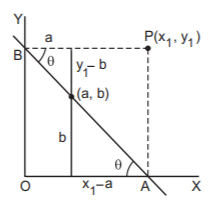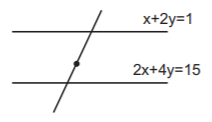1. A variable line through the point $$\left( {a,\,b} \right)$$ cuts the axes of reference at $$A$$ and $$B$$ respectively. The lines through $$A$$ and $$B$$ parallel to the $$y$$-axis and the $$x$$-axis respectively meet at $$P.$$ Then the locus of $$P$$ has the equation :
A.
$$\frac{x}{a} + \frac{y}{b} = 1$$
B.
$$\frac{x}{b} + \frac{y}{a} = 1$$
C.
$$\frac{a}{x} + \frac{b}{y} = 1$$
D.
$$\frac{b}{x} + \frac{a}{y} = 1$$
Answer :
$$\frac{a}{x} + \frac{b}{y} = 1$$
2. The triangle formed by the lines whose combined equation is $$\left( {{y^2} - 4xy - {x^2}} \right)\left( {x + y - 1} \right) = 0$$ is :
A.
equilateral
B.
right angled
C.
isosceles
D.
obtuse angled
Answer :
right angled
3. Let $$A\left( {\alpha ,\,\frac{1}{\alpha }} \right),\,B\left( {\beta ,\,\frac{1}{\beta }} \right),\,C\left( {\gamma ,\,\frac{1}{\gamma }} \right)$$ be the vertices of a $$\Delta ABC,$$ where $$\alpha ,\,\beta $$ are the roots of the equation $${x^2} - 6{p_1}x + 2 = 0,\,\beta ,\,\gamma $$ are the roots of the equation $${x^2} - 6{p_2}x + 3 = 0$$ and $$\gamma ,\,\alpha $$ are the roots of the equation $${x^2} - 6{p_3}x + 6 = 0,\,{p_1},\,{p_2},\,{p_3}$$ being positive. Then, the coordinates of the centroid of $$\Delta ABC$$ is :
A.
$$\left( {1,\,\frac{{11}}{{18}}} \right)$$
B.
$$\left( {0,\,\frac{{11}}{8}} \right)$$
C.
$$\left( {2,\,\frac{{11}}{{18}}} \right)$$
D.
None of these
Answer :
$$\left( {2,\,\frac{{11}}{{18}}} \right)$$
4. The three lines whose combined equation is $${y^3} - 4{x^2}y = 0$$ form a triangle which is :
A.
isosceles
B.
equilateral
C.
right angled
D.
none of these
Answer :
none of these
5. If the lines $$y = \left( {2 + \sqrt 3 } \right)x + 4$$ and $$y = kx + 6$$ are inclined at an angle $${60^ \circ }$$ to each other, then the value of $$k$$ will be :
A.
$$1$$
B.
$$2$$
C.
$$ - 1$$
D.
$$ - 2$$
Answer :
$$ - 1$$
6. If $$P\left( {1 + \frac{t}{{\sqrt 2 }},\,2 + \frac{t}{{\sqrt 2 }}} \right)$$ be any point on a line then the range of values of $$t$$ for which the point $$P$$ lies between the parallel lines $$x+2y=1$$ and $$2x+4y=15$$ is :
A.
$$ - \frac{{4\sqrt 2 }}{5} < t < \frac{{5\sqrt 2 }}{6}$$
B.
$$0 < t < \frac{{5\sqrt 2 }}{6}$$
C.
$$ - \frac{{4\sqrt 2 }}{5} < t < 0$$
D.
none of these
Answer :
$$ - \frac{{4\sqrt 2 }}{5} < t < \frac{{5\sqrt 2 }}{6}$$
7. The diagonals of the parallelogram whose sides are $$lx + my + n = 0,\,lx + my + n’ = 0,\,mx + ly + n = 0$$ and $$mx + ly + n'= 0$$ include an angle :
A.
$$\frac{\pi }{3}$$
B.
$$\frac{\pi }{2}$$
C.
$${\tan ^{ - 1}}\left( {\frac{{{l^2} - {m^2}}}{{{l^2} + {m^2}}}} \right)$$
D.
$${\tan ^{ - 1}}\left( {\frac{{2lm}}{{{l^2} + {m^2}}}} \right)$$
Answer :
$$\frac{\pi }{2}$$
8. If the angle between the two lines represented by $$2{x^2} + 5xy + 3{y^2} + 6x + 7y + 4 = 0$$ is $${\tan ^{ - 1}}m,$$ then $$m$$ is equal to :
A.
$$\frac{1}{5}$$
B.
$$1$$
C.
$$\frac{7}{5}$$
D.
$$7$$
Answer :
$$\frac{1}{5}$$
9. If $$P = \left( {1,\,0} \right),\,Q = \left( { - 1,\,0} \right)$$ and $$R = \left( {2,\,0} \right)$$ are three given points, then locus of the point $$S$$ satisfying the relation $$S{Q^2} + S{R^2} = 2S{P^2},$$ is-
A.
a straight line parallel to $$x$$-axis
B.
a circle passing through the origin
C.
a circle with the centre at the origin
D.
a straight line parallel to $$y$$-axis
Answer :
a straight line parallel to $$x$$-axis
10. The middle point of the segment of the straight line joining the points $$\left( {p,\,q} \right)$$ and $$\left( {q,\, - p} \right)$$ is $$\left( {\frac{r}{2},\,\frac{s}{2}} \right).$$ What is the length of the segment ?
A.
$$\frac{{\left[ {{{\left( {{s^2} + {r^2}} \right)}^{\frac{1}{2}}}} \right]}}{2}$$
B.
$$\frac{{\left[ {{{\left( {{s^2} + {r^2}} \right)}^{\frac{1}{2}}}} \right]}}{4}$$
C.
$${\left( {{s^2} + {r^2}} \right)^{\frac{1}{2}}}$$
D.
$$s + r$$
Answer :
$${\left( {{s^2} + {r^2}} \right)^{\frac{1}{2}}}$$

